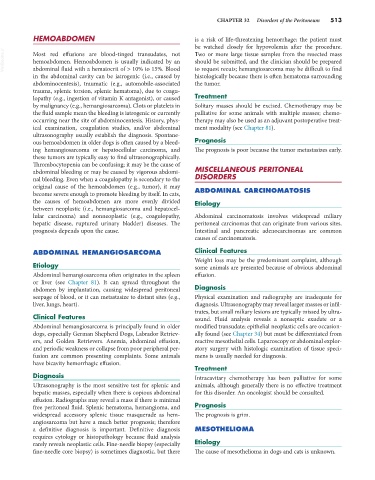Page 541 - Small Animal Internal Medicine, 6th Edition
P. 541
CHAPTER 32 Disorders of the Peritoneum 513
HEMOABDOMEN is a risk of life-threatening hemorrhage; the patient must
be watched closely for hypovolemia after the procedure.
VetBooks.ir Most red effusions are blood-tinged transudates, not Two or more large tissue samples from the resected mass
should be submitted, and the clinician should be prepared
hemoabdomen. Hemoabdomen is usually indicated by an
abdominal fluid with a hematocrit of > 10% to 15%. Blood
histologically because there is often hematoma surrounding
in the abdominal cavity can be iatrogenic (i.e., caused by to request recuts; hemangiosarcoma may be difficult to find
abdominocentesis), traumatic (e.g., automobile-associated the tumor.
trauma, splenic torsion, splenic hematoma), due to coagu-
lopathy (e.g., ingestion of vitamin K antagonist), or caused Treatment
by malignancy (e.g., hemangiosarcoma). Clots or platelets in Solitary masses should be excised. Chemotherapy may be
the fluid sample mean the bleeding is iatrogenic or currently palliative for some animals with multiple masses; chemo-
occurring near the site of abdominocentesis. History, phys- therapy may also be used as an adjuvant postoperative treat-
ical examination, coagulation studies, and/or abdominal ment modality (see Chapter 81).
ultrasonography usually establish the diagnosis. Spontane-
ous hemoabdomen in older dogs is often caused by a bleed- Prognosis
ing hemangiosarcoma or hepatocellular carcinoma, and The prognosis is poor because the tumor metastasizes early.
these tumors are typically easy to find ultrasonographically.
Thrombocytopenia can be confusing; it may be the cause of
abdominal bleeding or may be caused by vigorous abdomi- MISCELLANEOUS PERITONEAL
nal bleeding. Even when a coagulopathy is secondary to the DISORDERS
original cause of the hemoabdomen (e.g., tumor), it may ABDOMINAL CARCINOMATOSIS
become severe enough to promote bleeding by itself. In cats,
the causes of hemoabdomen are more evenly divided Etiology
between neoplastic (i.e., hemangiosarcoma and hepatocel-
lular carcinoma) and nonneoplastic (e.g., coagulopathy, Abdominal carcinomatosis involves widespread miliary
hepatic disease, ruptured urinary bladder) diseases. The peritoneal carcinomas that can originate from various sites.
prognosis depends upon the cause. Intestinal and pancreatic adenocarcinomas are common
causes of carcinomatosis.
ABDOMINAL HEMANGIOSARCOMA Clinical Features
Weight loss may be the predominant complaint, although
Etiology some animals are presented because of obvious abdominal
Abdominal hemangiosarcoma often originates in the spleen effusion.
or liver (see Chapter 81). It can spread throughout the
abdomen by implantation, causing widespread peritoneal Diagnosis
seepage of blood, or it can metastasize to distant sites (e.g., Physical examination and radiography are inadequate for
liver, lungs, heart). diagnosis. Ultrasonography may reveal larger masses or infil-
trates, but small miliary lesions are typically missed by ultra-
Clinical Features sound. Fluid analysis reveals a nonseptic exudate or a
Abdominal hemangiosarcoma is principally found in older modified transudate; epithelial neoplastic cells are occasion-
dogs, especially German Shepherd Dogs, Labrador Retriev- ally found (see Chapter 34) but must be differentiated from
ers, and Golden Retrievers. Anemia, abdominal effusion, reactive mesothelial cells. Laparoscopy or abdominal explor-
and periodic weakness or collapse from poor peripheral per- atory surgery with histologic examination of tissue speci-
fusion are common presenting complaints. Some animals mens is usually needed for diagnosis.
have bicavity hemorrhagic effusion.
Treatment
Diagnosis Intracavitary chemotherapy has been palliative for some
Ultrasonography is the most sensitive test for splenic and animals, although generally there is no effective treatment
hepatic masses, especially when there is copious abdominal for this disorder. An oncologist should be consulted.
effusion. Radiographs may reveal a mass if there is minimal
free peritoneal fluid. Splenic hematoma, hemangioma, and Prognosis
widespread accessory splenic tissue masquerade as hem- The prognosis is grim.
angiosarcoma but have a much better prognosis; therefore
a definitive diagnosis is important. Definitive diagnosis MESOTHELIOMA
requires cytology or histopathology because fluid analysis
rarely reveals neoplastic cells. Fine-needle biopsy (especially Etiology
fine-needle core biopsy) is sometimes diagnostic, but there The cause of mesothelioma in dogs and cats is unknown.

